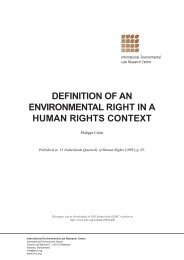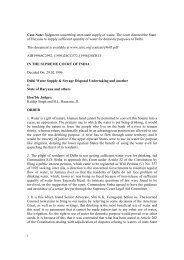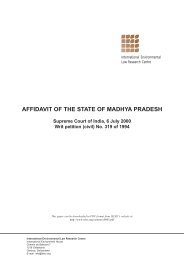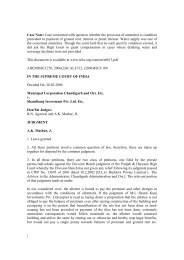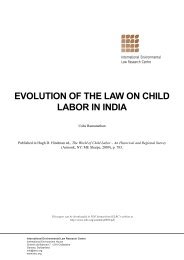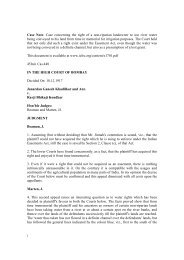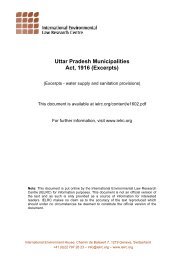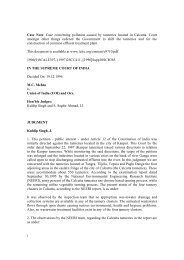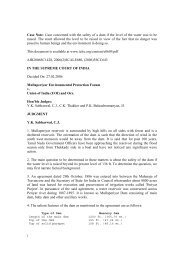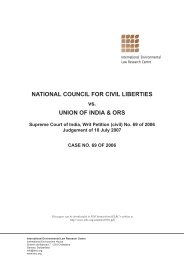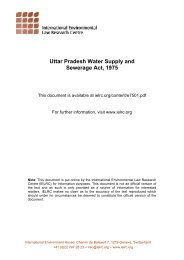Narmada Bachao Andolan vs. Union of India - International ...
Narmada Bachao Andolan vs. Union of India - International ...
Narmada Bachao Andolan vs. Union of India - International ...
Create successful ePaper yourself
Turn your PDF publications into a flip-book with our unique Google optimized e-Paper software.
General issues relating to displacement <strong>of</strong> tribals and alleged violation <strong>of</strong> the rights under Article 21 <strong>of</strong> theConstitutionThe submission <strong>of</strong> Shri Shanti Bhushan, learned senior counsel for the petitioners was that the forcible displacement<strong>of</strong> tribals and other marginal farmers from their land and other sources <strong>of</strong> livelihood for a project which was not inthe national or public interest was a violation <strong>of</strong> their fundamental rights under Article 21 <strong>of</strong> the Constitution <strong>of</strong><strong>India</strong> read with ILO Convention 107 to which <strong>India</strong> is a signatory. Elaborating this contention, it was submittedthat this Court had held in a large number <strong>of</strong> cases that international treaties and covenants could be read into thedomestic law <strong>of</strong> the country and could be used by the courts to elucidate the interpretation <strong>of</strong> fundamental rightsguaranteed by the Constitution. Reliance in support <strong>of</strong> this contention was placed on Gramaphone Co. <strong>of</strong> <strong>India</strong>Ltd. v. B.B.Pandey, 1984 (2) SCC 534, PUCL v. <strong>Union</strong> <strong>of</strong> <strong>India</strong>, 1997 (3) SCC 433 and CERC v. <strong>Union</strong> <strong>of</strong> <strong>India</strong>,1995 (3) SCC 42. In this connection, our attention was drawn to the ILO Convention 107 which stipulated thattribal populations shall not be removed from their lands without their free consent from their habitual territoriesexcept in accordance with national laws and regulations or reasons relating to national security or in the interest <strong>of</strong>national economic development. It was further stated that the said Convention provided that in such cases whereremoval <strong>of</strong> this population is necessary as an exceptional measure, they shall be provided with lands <strong>of</strong> quality atleast equal to that <strong>of</strong> lands previously occupied by them, suitable to provide for their present needs and futuredevelopment. Shri Shanti Bhushan further contended that while Sardar Sarovar Project will displace and have animpact on thousands <strong>of</strong> tribal families it had not been proven that this displacement was required as an exceptionalmeasure. He further submitted that given the seriously flawed assumptions <strong>of</strong> the project and the serious problemswith the rehabilitation and environmental mitigation, it could not said that the project was in the national interest.It was also submitted that the question arose whether the Sardar Sarovar Project could be said to be in the nationaland public interest in view <strong>of</strong> its current best estimates <strong>of</strong> cost, benefits and evaluation <strong>of</strong> alternatives and specificallyin view <strong>of</strong> the large displacement <strong>of</strong> tribals and other marginal farmers involved in the project. Elaborating thiscontention, it was contended that serious doubts had been raised about the benefits <strong>of</strong> the project – the veryrationale which was sought to justify the huge displacement and the massive environmental impacts etc. It wascontended on behalf <strong>of</strong> the petitioners that a project which was sought to be justified on the grounds <strong>of</strong> providinga permanent solution to water problems <strong>of</strong> the drought-prone areas <strong>of</strong> Gujarat would touch only the fringes <strong>of</strong>these areas, namely Saurashtra and Kachchh and even this water, which was allocated on paper, would not reallyaccrue due to host <strong>of</strong> reasons. It was contended that inspite <strong>of</strong> concentrating on small-scale decentralised measureswhich were undertaken on a large scale could address the water problem <strong>of</strong> these drought-prone areas. Hugeportions <strong>of</strong> the State resources were being diverted to the Sardar Sarovar Project and as a result the small projectswere ignored and the water problem in these areas persists. It was submitted that the Sardar Sarovar Project couldbe restructured to minimise displacement.83. Refuting the aforesaid arguments, it has been submitted on behalf <strong>of</strong> the <strong>Union</strong> <strong>of</strong> <strong>India</strong> and the State <strong>of</strong>Gujarat that the petitioners have given a highly exaggerated picture <strong>of</strong> the submergence and other impacts <strong>of</strong> thisproject. It was also submitted that the petitioner’s assertion that there was large-scale relocation and uprooting <strong>of</strong>tribals was not factually correct. According to respondents, the project would affect only 245 villages in Gujarat,Maharashtra and Madhya Pradesh due to pondage and backwater effect corresponding to 1 in 100 year flood. Thestate-wise break up <strong>of</strong> affected villages and the number <strong>of</strong> project affected families (PAFs) shows that only fourvillages would be fully affected (three in Gujarat and one in Madhya Pradesh) and 241 would be partially affected(16 in Gujarat, 33 in Maharashtra and 192 in Madhya Pradesh). The total project affected families who would beaffected were 40,827. The extent <strong>of</strong> the submergence was minimum in the State <strong>of</strong> Madhya Pradesh. The picture<strong>of</strong> this submergence as per the Government <strong>of</strong> Madhya Pradesh Action Plan <strong>of</strong> 1993 is as follows:Abadi will be fully submerged in 39 villages and partially in 116 villages, agricultural land will beaffected upto 10 percent in 82 villages, upto 26 percent in 32 villages, 26 to 50 percent in 30 villages, 51to 75 percent in 14 villages, 76 to 90 percent in 4 villages and 100 percent in only 1 village. In 21villages, only abadi will be affected and Government land only in 9 villages. Thus, in most <strong>of</strong> thevillages, submergence is only partial.The submergence area <strong>of</strong> the SSP can be divided into two areas:i) Fully tribal, hilly area covering the initial reach <strong>of</strong> about 105 villages with mainly subsistence economy. Itincludes 33 villages <strong>of</strong> Maharashtra, 19 <strong>of</strong> Gujarat and about 53 <strong>of</strong> Madhya Pradesh.(ii) Mixed population area in the plains <strong>of</strong> Nimad, with a well developed economy and connected to the mainstream.This area includes about 140 villages in Madhya Pradesh.13



